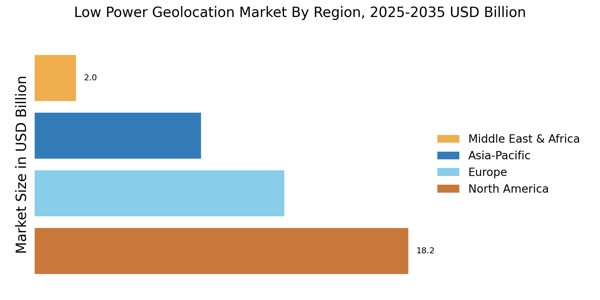Emergence of Wearable Technology
The emergence of wearable technology is reshaping the landscape of the Low Power Geolocation Market. Wearable devices, such as fitness trackers and smartwatches, increasingly incorporate geolocation features to provide users with valuable insights into their activities and surroundings. This trend is driving demand for low power geolocation solutions that can operate efficiently without draining battery life. As the wearable technology market continues to expand, the integration of advanced geolocation capabilities is becoming a key differentiator for manufacturers. The Low Power Geolocation Market is likely to see substantial growth as more consumers adopt wearable devices that leverage these technologies.
Growth of Smart City Initiatives
The growth of smart city initiatives is driving the Low Power Geolocation Market as urban areas increasingly adopt technology to improve infrastructure and services. Geolocation plays a vital role in smart city applications, including traffic management, public safety, and environmental monitoring. As cities strive to enhance the quality of life for residents, the integration of low power geolocation solutions becomes essential. Reports suggest that investments in smart city projects are expected to reach significant levels, thereby creating opportunities for the Low Power Geolocation Market to expand. This trend indicates a shift towards more connected urban environments, where geolocation technology is integral to operational efficiency.
Advancements in Sensor Technology
Technological advancements in sensor technology are significantly influencing the Low Power Geolocation Market. Innovations in miniaturization and energy efficiency have led to the development of highly accurate and low-power sensors that can be integrated into various devices. These sensors enable precise tracking and positioning, which is crucial for applications in smart cities, automotive navigation, and wearable technology. The market is witnessing a shift towards more sophisticated sensor solutions, which are expected to enhance the capabilities of geolocation systems. As a result, the Low Power Geolocation Market is likely to benefit from these advancements, with an anticipated increase in adoption rates across multiple sectors.
Increased Focus on Asset Tracking
The increased focus on asset tracking is a notable driver of the Low Power Geolocation Market. Businesses across various sectors are recognizing the importance of real-time tracking of assets to improve operational efficiency and reduce losses. This trend is particularly pronounced in industries such as logistics, manufacturing, and healthcare, where the ability to monitor assets in real-time can lead to substantial cost savings. The market for asset tracking solutions is projected to grow significantly, indicating a rising demand for low power geolocation technologies that facilitate this process. Consequently, the Low Power Geolocation Market is poised to benefit from this heightened focus on asset management.
Rising Demand for Location-Based Services
The increasing demand for location-based services is a primary driver of the Low Power Geolocation Market. As businesses and consumers seek more personalized experiences, the need for accurate geolocation data has surged. This trend is particularly evident in sectors such as retail, logistics, and transportation, where companies leverage geolocation to enhance customer engagement and optimize operations. According to recent estimates, the market for location-based services is projected to reach substantial figures, indicating a robust growth trajectory. This demand is further fueled by the proliferation of mobile devices and applications that rely on geolocation technology, thereby creating a fertile environment for the Low Power Geolocation Market to thrive.

















Leave a Comment